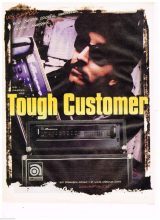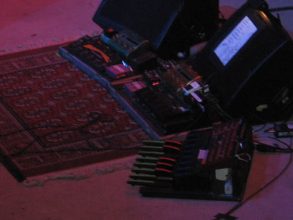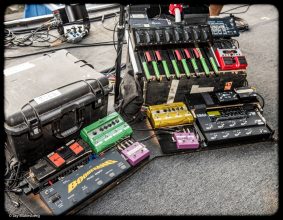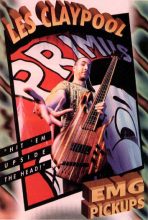Les Claypool Amplifier and Effects rig – Primus (2/2)
Welcome back, It’s part 2 of Les Claypool’s Amplifier and Effects Rig. Les’ amplifier rig is a little bit of a mystery. While he endorsed both Mesa Boogie and Ampeg over the years, it seems he was never satisfied with his rig. Swapping amplifiers and cabinets, in and out more than any other bass player covered on the channel.
Did you watch the video?! Would you like to know when the next one is out?
Contents
- 1 Primus Amplifier and Effects on Suck on This (1989)
- 2 Amplifiers on Sailing the Seas of Cheese tour (1992)
- 3 Experimenting with Amplifiers (1992)
- 4 Primus Television spots and new amplifiers
- 5 Amplifiers and effects on Pork Soda (1993)
- 6 Introducing the Mesa Boogie PH1000 amplifier
- 7 Primus and the cultural peak (1995)
- 8 Primus return to television (1995)
- 9 Amplifiers and effects on the Brown Album (1997)
- 10 Amplifiers in Videoplasty (1998)
- 11 Les tries Ampeg – Again (1998)
- 12 Recording Antipop with no amplifiers (1999)
- 13 Amplifiers and effects at Ozzfest (1999)
- 14 Les and the Ampeg amplifiers – third time lucky
- 15 Les amplifiers and effects in Oysterhead (2000)
- 16 More Ampeg amplifiers for Les please
- 17 Les amplifier and effects for Primus reunion
- 18 Claypool Lennon Delirium and Primus 2018
- 19 Les Claypool’s Effects Pedals
- 20 Replacing the ADA MP1
- 21 Les Claypool effects in Oysterhead
- 22 Answers from Les’ Bass Tech Ryan Becker
- 23 Les Claypool’s Pickups
- 24 Les Claypool and strings
- 25 More from Know Your Bass Player
- 26 Watch more from Know Your Bass Player
- 27 Be the first to watch the next Know Your Bass Player
Primus Amplifier and Effects on Suck on This (1989)
The earliest we see of Les Claypool’s amplifier and effects rig is a single 15 inch cabinet with an 8 inch high frequency driver Made by Electro Voice. The head on top of this cab is believed to be an SWR SM 400S which Les owned around this period.
- Electrovoice EV115N
- SWR SM400S
This was used in the live sessions for KZSU radio in Stanford California 1989 and live shows at this time.
One year later following the success of the live album “Suck on This”. Les is photographed at a show at the Haight-Ashbury Street Fair. In this photo Les has now switched to Mesa Boogie with a rig now of;
- 400 Plus Mesa Boogie amplifier
- 2×15 inch Mesa Boogie cabinets
Also in his rack is an ADA MP-1 preamp with the MC1 controller. This configuration will become the core of Les’ bass rig.
Amplifiers on Sailing the Seas of Cheese tour (1992)
In the summer of 1992 we see a slight change to the rig. With Les now using Ampeg equipment.
- Ampeg 8×10 inch cabinet
- Original Ampeg SVT
A month later in an interview taken from Guitar Player, August 1991. Les mentions he uses a Mesa rig and nothing about Ampeg. This is reflected in the debut music video “Jerry Was a Race Car Driver” as we see his core Boogie rig.
Experimenting with Amplifiers (1992)
In 1992 and we see some experimentation. Primus were touring early that year and shows from this period give us the introduction of a 4×10 SWR cabinet with a Boogie 15 underneath.
- 4×10 inch Goliath II (2) SWR cabinet
- 2×15 inch Mesa Boogie cabinet
Primus Television spots and new amplifiers
Primus performed on MTV’s Spring Break and the Dennis Miller show later that year (1992).
On stage this time was a Gallien Krueger 800RB head and now two SWR 4x10s. Mentioned in an interview at the time Les stated
“My sound has all this weird shit in the high end; you can hear it through 10’s but not 15’s.”
Amplifiers and effects on Pork Soda (1993)
Pork Soda* was released in 1993 and in the video D.M.V we see the Mesa Boogie rig back onstage.
- 400 Plus (Mesa Boogie)
- 2×15 inch Mesa Boogie cabinets (x2)
- ADA MP-1
- ADA Stereo Tapped Delay
Les now also has a second ADA preamp which he declared a backup.
Introducing the Mesa Boogie PH1000 amplifier
Primus again moving into the mainstream show up on an MTV Halloween Special in 1993. This time Les has two Mesa Boogie PH1000’s A year later, they were dropped in favour of the core rig, returning in Woodstock 1994.
Primus and the cultural peak (1995)
Moving into the height of Primus’ cultural peak came “Tales From the Punch Bowl*” (1995). With the first video being “Wynona’s Big Brown Beaver”.
A portable amplifier was seen in this video made by Ampeg.
It returns again in Duo De Twang.
The Punch Bowl tour sees Les return back to the core rig and using either 1 or 2 Boogie 15 inch cabinets.
Primus return to television (1995)
The Punchbowl era sees Primus appearing on prime time television programs. With performances on Conan O’Brien and the David Letterman show in 1995. A second appearance on Conan came in 1997 and Les used the same gear.
Here you would typically see Les using
- ADA MP2 (x2)
- Wireless receiver (unnamed)
- ADA Stereo Tapped Delay
- One or two 2×15 inch Mesa Boogie cabinets
Amplifiers and effects on the Brown Album (1997)
The Brown Album* was recorded using a 12 inch solid state Gallien Krueger* practice amplifier.
Les mentions in an interview in 1997.
His amp? A small solid-state Gallien-Krueger …
“For me,” says Les, “it’s easier to get tones out of smaller, quieter amps, because you’re not feeling the big sound in the room, but just hearing what the mike hears. The mike can’t feel the rumble that you feel through the ground.
A New Brown Sound – 1997
Amplifiers in Videoplasty (1998)
In 1998 Primus released their home video Videoplasty complementing the recent EP named Rhinoplasty.
In footage from this video a PH1000s returns and is seen offstage.
Les tries Ampeg – Again (1998)
Around this time on a German TV special, Les makes an appearance with a set of Ampeg equipment
- 4×10 inch Ampeg cabinets (x2)
- Ampeg SVT 3 Pros* (x3)
Recording Antipop with no amplifiers (1999)
According to Les in an interview at the time .
To record most of AntiPop … Les recorded direct with no miked-amp tracks.
For most songs he plugged into his trusty ADA MP-2 guitar preamp (not the same model as the MB-1 bass preamp he shilled for years in the now-defunct company’s ads).A rackmount Lexicon MPX G2 multi-effect served as both preamp and delay. In certain places he also used an MXR Phase Shifter, Larry Lalonde’s vintage Mu-Tron, and “a Korg envelope follower of some sort [AX300B].
Antipop till you drop – Bass Player Magazine 1999
Amplifiers and effects at Ozzfest (1999)
Primus toured Antipop at Ozzfest in 1999 and it’s here we have one of the clearest pictures of Les’ rig at this time.
- Two PH1000’s on either side with a funky leather casing
- Two 2×15 inch cabinets underneath
- Furman power supply
- A wireless receiver
- ADA MP2 (x2)
- DBX 160a compressor
- Ampeg SVT3 pros* (x3)
Les and the Ampeg amplifiers – third time lucky
Seen at a show that October 1999 it would seem that Les tries different Ampeg equipment again, using.
- Two 8×10 cabinets
- Two new Ampeg MTI SVT heads.
If you’re not familiar with these, you’ll find that cosmetic changes were brought in about the early ’80s. This is due to Ampeg being purchased by Japanese firm, MTI (Music Technology, Inc). Therefore this is known as the Ampeg MTI era.
Offshore Festival (2000)
Above the SVTs are what looks like two Gallien Krueger 800RBs but there is no information why they would be there.
Les amplifiers and effects in Oysterhead (2000)
Primus went on hiatus in 2000 and Les created supergroup Oysterhead. For this group a new rig was used.
- Four Ampeg PR410’s
- Two Ampeg PR215’s
- Ampeg SVT2 Pro’s
- DTR2 Korgworks tuner
- DBX 160a compressor
These PR cabs have high frequency drivers in them, enhancing their high end.
The ADA preamps and delay was completely removed from the rig. Les now relies on effects pedals to do the same job.
More Ampeg amplifiers for Les please
Throughout Oysterhead, Les keeps the same cabinets but cycles through amplifiers.
He’s seen throughout this period using an original SVT, SVT2’s, SVT3’s, SVT4’s and SVT5’s. With no particular reason for changing so frequently.
.
Les officially endorsed the SVT3 PRO (blue stripe model) in the 90’s. As well as the normal SVT-3 and 4 on the Ampeg site from 2013.
During side projects
This modern Ampeg rig was used throughout the mid 2000’s and was also used in further side projects such as Colonel Les Claypool’s Fearless Flying Frog Brigade, Bucket of Bernie Brains and Primus in 2003. Swapping the heads out as he saw fit.
There was some deviation in 2006 with some Ampeg 8x10s being reintroduced. Inevitably, these cabs were used on an off right up until 2015.
Never settle for less
To make things even more confusing, Les never settled with the 8×10’s. Sometimes he went back to PR cabs or tried the newest SVT Neo cabs at the time.
Les amplifier and effects for Primus reunion
By 2007 a new iteration of the rig debuted and primarily consisted API rack strips
- API 7600 input modules (x2)
- Mackie FRS 2800 power amplifier
Having spoken highly about his experience with an API console in the past, It’s clear Les wanted to recreate this on stage.
I bought this old API console, which is phenomenal
The Many Colors of Les Claypool – Bass Player Magazine 2017
The equipment here was kept the same until 2015 which brings us to the current Claypool amplifier rig.
Claypool Lennon Delirium and Primus 2018
Seen in Claypool Lennon Delirium and recent Primus shows in 2018. Les returns to his former glory with a Mesa Boogie Endorsement. Using Subway D-800 Heads and up to four Subway ultra light 12’s.
- D-800 head* (x2)
- Subway ultra light 12 inch cabinet* (x4)
Les Claypool’s Effects Pedals
Les has said on more than one occasion he isn’t much of a gear head.
I’m not a big gear head. I’ve just accumulated things over the years …
Les Claypool and the ADA preamp
For much of the early Primus catalog you’ll find the MP1 and the MP2 which are responsible for much of Les’ sounds.
The ADA MP-1 Guitar Preamp is a MIDI-controlled rack-mountable effects unit featuring overdrive, chorus and EQ functionality.
Les mentions in a 1992 interview.
“Les uses an ADA MP-1 guitar preamp that was modified by ADA’s Tod Langer. “He did something to the EQ circuitry so the lows pass through better, and he also did something to the compressor to give me more bottom end.
I use only about nine sounds on it, just to cut treble, cut bass, or add a little crunch.” an identical MP-1 sits in his rack as a spare. Programs are selected with a MIDI Ground Control footpedal made by Digital Music.”
Les Claypool gets a Taste of the Big Time – Bass Player Magazine – 1992
Les often paired this with the MC-1 MIDI foot controller and later on a upgraded this to a controller made by Digital Music.
Replacing the ADA MP1
The MP2 replaced the MP1 around 1995, adding more functionality but essentially performing identically.
The MP2 preamp was used to record Antipop. In addition, a short list of gear was added to the production.
- Lexicon MPX G2 multi-effect serving as both preamp and delay
- MXR Phase Shifter*
- Larry Lalonde’s vintage Mu-Tron,
- Korg AX300B
- Access Virus analog synth
Les Claypool effects in Oysterhead
On stage with Oysterhead from the year 2000. The foundations of Les’ pedal board was starting to take shape. The ADA preamps were removed in favour of well known effects pedals.
The main layout of this pedal board is in three panels and essentially boils down to a midi section, distortion and then modulation.
These boards are split up using various A/B and ABY switchers. This can give access to one board at at time or make combinations of everything in between.
Effects on the midi pedal board (far right)
On the midi board starting far right
- Roland PK-5 a dynamic midi pedal
- Access Virus
- BOSS VE vocal performer* (added in 2017)
- Monitor control made by Avid (added in 2017)
Effects on the distortion board (middle panel)
The distortion board at one point had;
- BOSS TU-2 tuner*
- Red Line 6 amplifier modeler. / Replaced by the gold Distortion Modeler
- Korg AXB300 multi effects pedal / Replaced by the Korg AX8.
Effects on the modulation panel (far left)
Finishing with modulation;
- Green Line 6 delay modeler*
- AirTurn Bluetooth pedal* which allows you to wirelessly control page turning on an iPad.
- Original Boomerang Phrase Sampler.
Les was in admiration of Treys boomerang and decided he wanted one too. Stating “The original version has a lo-fi quality.
Answers from Les’ Bass Tech Ryan Becker
By 2017 we finally get some answers from Les’ bass tech Ryan Becker who provides some clarity.
“Claypool’s basses feed a Shure wireless system; after a switcher, his signal encounters a Distortion Modeler,
Delay Modeler, and first-generation Boomerang Phrase Sampler.These go in the effect loop of a Fractal Audio Systems AX8 Amp Modeler + Multi FX, which sends a signal to the house. “
Recording Desaturating Seven
The tech also commented on the recording of Desaturating Seven*, stating.
“Claypool’s signal chain was even simpler:
just his old MXR 10-band graphic EQ and MXR M80 Bass D.I.+, which also provided distortion.”
Les Claypool’s Pickups
Les has used EMG pickups since the very first Carl Thompson bass back in 1989.
Primarily he has always used an EMG ceramic humbucker on every bass, including the resonator bass.
Les endorsed by them today and uses the following models.
- 35DC
- 35P4
- 40DC
- 45DC
Les Claypool and strings
The earliest mention of what strings Les use was in a 1992 interview which stated;
Les uses Dean Markley nickel roundwounds
–but here’s the secret: his set consists of two A strings (.080) and two G strings (.040). … to make my chords sound better.”
Les Claypool gets a Taste of the Big Time 1992
By 2006 Les changes from Dean Markley Nickels to the Blue Steel strings and then from 2011 right up to current day. Les uses Dunlop custom strings.
- Dean Markley Nickel Roundwounds (.40 – .100) 2602A
- Dean Markley Blue Steels (.40 – .100) 2670XL
- Jim Dunlop Customs (.40 – .100 Maybe?)
There is no information about what the gauge Les is currently using. It is likely to be a similar gauge to the 40’s to 100 used in the past 15 years.
More from Know Your Bass Player
After the Les Claypool Bass Rig series we are taking a look at Lemmy from Motorhead. If there’s a bassist you want to see, then get in touch!
Tweet me and subscribe on YouTube.
Watch more from Know Your Bass Player
Have you enjoyed your time here? Want to know when the next video is out?
*Some of the links above are affiliate links, which means that if you choose to make a purchase from that site, we will earn a commission. As a result this commission comes at no additional cost to you and helps support our site and video series.




